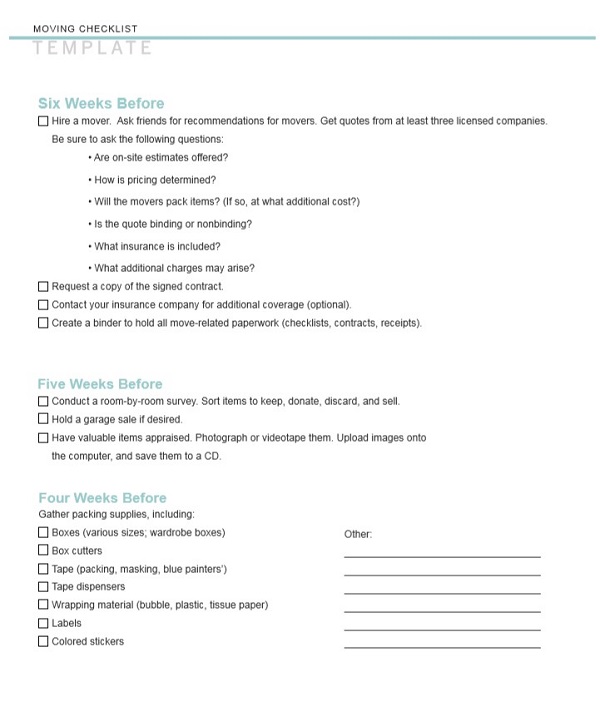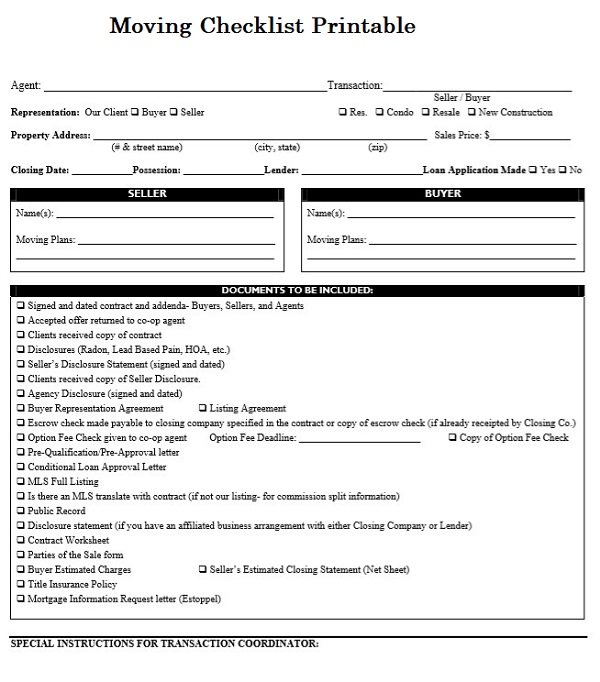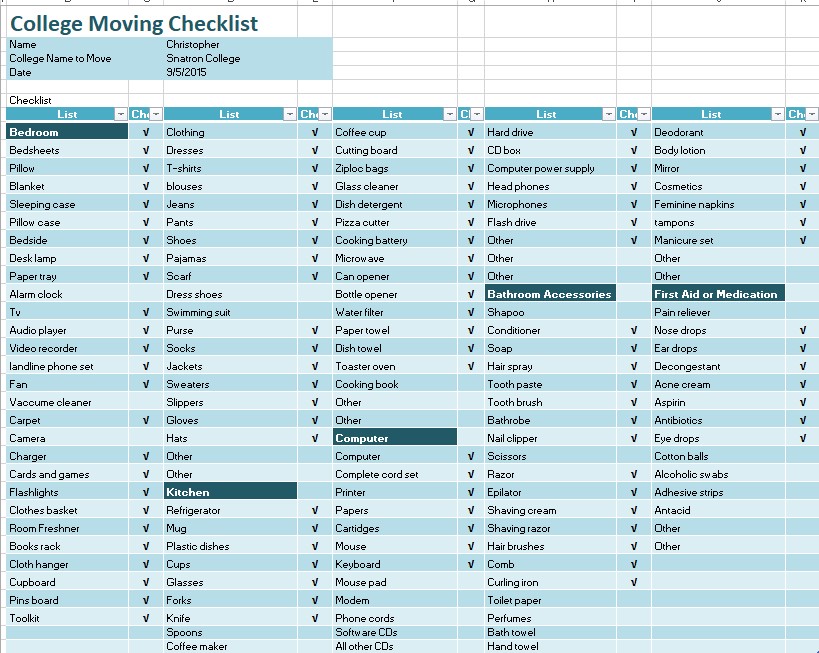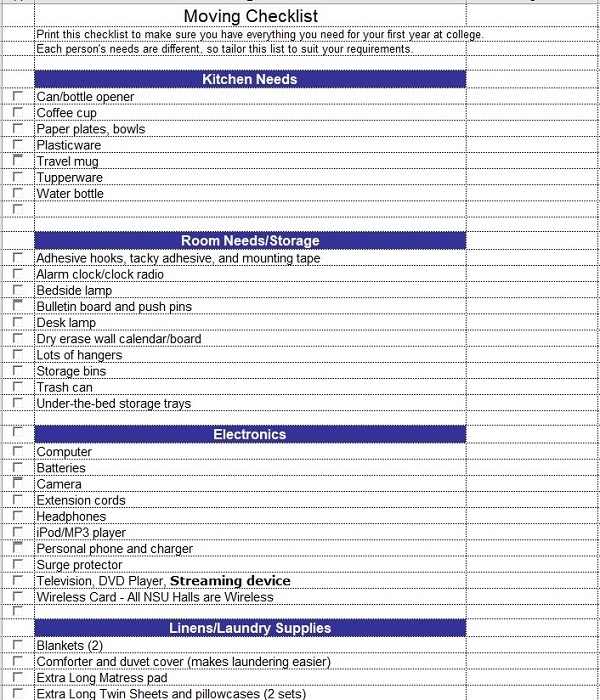The moving checklist must be made for helping people to control their stress under one of the most stressful moments in their life, moving. There are so many things which must be relocated to the new place but we can make sure that it can be organized better with the checklist.
Types of Moving Checklist
Here are some types of moving checklist which can be made.
Packing Checklist
A packing checklist is an essential tool when preparing for a move. It provides a comprehensive list of all the items that need to be packed, helping to ensure that nothing is overlooked. Here is how to create and use a packing checklist effectively:
Organization by Room or Category: One of the first decisions to make when creating a packing checklist is whether to organize it by room or by category. Organizing by room can be helpful because it allows you to focus on one space at a time. On the other hand, organizing by category (such as clothing, kitchenware, electronics, Etc.) can make it easier to ensure that similar items are packed together.
Detailed Listing: Your packing checklist should be as detailed as possible. Instead of just writing “kitchen items,” for example, list out the specific items like “pots and pans,” “cutlery,” “plates and bowls,” Etc. This level of detail can help ensure that everything is remembered.
Useful for Unpacking: A packing checklist is useful for packing and can be a valuable tool for unpacking in your new home. By referring back to your checklist, you can easily see where certain items are and unpack them in an organized manner.
Prioritizing Items: Not all items need to be packed simultaneously. Some things, like out-of-season clothing or rarely used appliances, can be packed well before your move. Other items, like everyday toiletries or coffee makers, must be packed last. Your packing checklist can help you prioritize what to pack and when.
Check Off as You Go: As you pack each item, check it off your list. It will give you a sense of progress and accomplishment and help prevent the mistake of packing the same items twice.
A packing checklist is a simple yet effective tool that can make the packing process more organized and less stressful. It ensures that every item is accounted for, making packing and unpacking easier and more efficient.
Open First Checklist
An Open-First Checklist is another essential tool during a move. This list contains items you will need immediately upon arrival at your new home. Here is how to create and use an Open-First Checklist effectively:
Identify Essential Items: The first step in creating an Open-First Checklist is instantly identifying the items you require after your move. These might include toiletries, a change of clothes, essential cooking utensils, basic cleaning supplies, and any necessary electronics like your phone charger or laptop.
Pack a Separate Box or Bag: Once you have determined your critical items, pack them in a different box or bag. It should be the final box you pack before going to your old house and the first one you open when you arrive at your new one.
Label Clearly: It is essential to clearly label your open-first box to confirm it is easily identifiable among all the other boxes. You may use another marker or tape color to make it stand out.
Consider Each Family Member’s Needs: If you are moving with a family, consider the unique needs of each family member. For instance, children might need certain toys or comfort items, while pets will need food and other supplies.
Do not Overpack: While it is essential to have essential items readily available, try not to overpack your open-first box. Remember, the goal is to have the essentials you require for the first day or two, not to pack everything you own.
Open-First Checklist can provide a smooth transition during a move. By identifying and packing important objects separately, you can instantly reduce stress and feel more at home when you come to your new place.
Moving Out Checklist
A Moving Out Checklist is a comprehensive list of tasks that must be completed before leaving your old home. This checklist can help you remember all important steps during the hustle and bustle of moving. Here is how to create and use a Moving Out Checklist effectively:
Notify Relevant Parties: List all the people, companies, and organizations that need to be notified about your move. It might include your utility companies, post office, bank, insurance, and other services.
Arrange for Services to be Disconnected: Schedule a date for your utilities and other benefits to be deactivated after your activity. It might include electricity, gas, water, internet, and cable.
Clean the Property: Plan to wash your old home before going. It is especially vital if you rent and want your security deposit back. Consider hiring professional cleaners if necessary.
Final Walkthrough: Schedule a moment to do a final walkthrough of your old home. It is your chance to check that everything has been remembered and that the property is neat and prepared for the following occupants.
Return Keys: Return your keys to your owner or property manager if leasing. If you are selling, arrange for the keys to be handed over to the new owners.
Address Change: change your address with the office and other relevant entities. It provides that your mail will be delivered to your latest address.
The Moving Out checklist can help you stay organized and confirm that all required tasks are completed before you leave your old home. By following this Checklist, you can have peace of mind knowing everything has been taken care of.
Moving In Checklist
It is a detailed list of tasks to be accomplished when settling into your new home. It helps ensure that all necessary steps are taken to make your new place comfortable and functional as soon as possible. Here is how to create and use a Moving In Checklist effectively:
Utility Setup: Ensure all utilities are set up and working correctly, including electricity, water, gas, internet, and cable. If any services were not set up before you moved, make arrangements as soon as possible.
Home Inspection: Do a thorough inspection. Check for any damages or issues that require to be addressed. It includes checking all appliances, plumbing, electrical, heating, and cooling systems.
Deep Cleaning: A deep cleaning before you start unpacking is suitable. It is easier to do when the home is cleared and provides a fresh beginning in your new home.
Unpacking: Start unpacking, beginning with essentials. It is useful to prepare where everything will go before you start. Unpack room by room, beginning with the considerably used rooms.
Change Locks: For safety causes, it is a fine opinion to change the locks when you drive into a further home. You must always understand who might have a replica of the old keys.
Register Your New Address:
- Don’t Remember to register your new address with the post office.
- Update your driver’s license.
- Inform any necessary companies or organizations about your move.
Meet the Neighbors: Take a moment to present yourself to your new neighbors. They can be a fantastic local information source and help you feel more at home in your new community.
Moving In checklist can assist you in remaining methodical and ensure all necessary tasks are completed when moving into your new home. Following this checklist lets you settle into your new home more quickly and easily.
Don’t Forget Checklist
A Don’t-Forget Checklist lists often overlooked tasks that must be completed during moving. It serves as a reminder of the small but important details that can easily slip through the cracks during a move. Here is what you might include on a Don’t-Forget Checklist:
Cancel or Transfer Services: Remember to cancel or transfer services such as utilities, cable, internet, and subscriptions. Remember gym memberships, clubs, or community organizations you are part of.
Change of Address Notifications: Notify all relevant parties of your change of address. It includes your bank, insurance companies, credit card companies, and any subscriptions you have. Also, remember to forward your mail to the postal service.
Medical Records and Prescriptions: If you are moving to a new city or state, transfer medical records to your new healthcare providers and ensure you have enough prescriptions during the transition.
School Records: If you have children, arrange for their school records to be transferred to their new school.
Return Borrowed Items: Return any borrowed items from neighbors, friends, or local organizations. It could include library books, tools, or dishes from a recent potluck.
Collect Deposits: If you have put down deposits for utilities, rent, or other services, collect them before you move.
Clean Your Old Home: Whether selling your old home or ending a lease, leaving it clean and in good condition is important. You may need to schedule a deep cleaning or do it yourself.
Plan for Pets: If you have pets, make sure you have planned for their move. It could include updating their tags, scheduling a vet visit, and packing their food, toys, and other essentials.
Personal Essentials: Pack a bag of essentials you will need immediately after the move. It could include toiletries, a change of clothes, important documents, and any medications you need.
Don’t-Forget Checklist can help ensure that all important tasks are remembered during the hustle and bustle of moving. Keeping track of these often overlooked tasks can make your move smoother and less stressful.
Example Of Moving Checklist Templates
Readers can use These moving checklist templates as a starting point for their checklists.
Moving Checklist PDF

This is a downloadable and printable version of a moving checklist. It can be a comprehensive list covering all the tasks you must complete before, during, and after your move. It’s convenient for those who prefer a physical copy of their checklist.
Moving Checklist Printable

This is a printable moving checklist you can print out and keep as you prepare for your move. It can be a detailed list of all the tasks you need to complete, and you can check off each task as you complete it.
Moving Checklist UK
This checklist is designed for people moving within or to the United Kingdom. It can include tasks specific to the UK, such as notifying the local council of your move, setting up a TV license, and more.
Moving Checklist Template

This customizable moving checklist you can tailor to your needs. It can be a basic template that you can add to or modify based on your moving situation.
Moving Checklist App
This digital version of a moving checklist is available on mobile devices. An app can offer additional features like reminders, sharing capabilities with other household members, and the ability to add or remove tasks as needed.
Moving Checklist Ontario
This checklist is designed for people moving within or to Ontario, Canada. It can include tasks specific to Ontario, such as updating health card information, driver’s license, etc.
Moving Checklist Apartment
This checklist is specifically designed for people moving into or out of an apartment. It can include tasks specific to apartment living, such as notifying the landlord, checking for damage, etc.
Moving Checklist Australia
This checklist is designed for people moving within or to Australia. It can include tasks specific to Australia, such as notifying the Australian Taxation Office, updating Medicare details, etc.
Moving Checklist BC
This checklist is designed for people moving within or to British Columbia, Canada. It can include tasks specific to BC, such as updating health card information, driver’s license, etc.
House Moving Checklist
This is a checklist designed for people moving houses. It can include tasks specific to moving houses, such as transferring utilities, updating home insurance, etc.
Cross Country Moving Checklist
This checklist is specifically designed for those moving across the country. It includes tasks unique to long-distance moves, such as arranging vehicle transportation and updating driver’s license information.
Moving Checklist Address Change

This is a downloadable and printable checklist for moving houses. It includes a comprehensive list of tasks that must be completed before, during, and after the move.
New House Moving Checklist
This checklist is designed for those moving into a new house. It includes setting up utilities, cleaning the new house, and unpacking essentials.
Interstate Moving Checklist
This checklist is for those moving from one state to another. It includes tasks like updating car registration and insurance, researching state laws and planning the route for the move.
Day of Moving Checklist
This checklist is designed to keep you organized on the actual day of the move. It includes tasks like doing a final walkthrough of the old house, ensuring all items are packed, and coordinating with the moving company.
Overseas Moving Checklist
This checklist is for those moving to a different country. It includes arranging for international shipping, obtaining necessary visas and permits, and preparing for cultural adjustments.
Moving House Checklist
This is a general checklist for moving houses. It includes tasks like packing, hiring movers, and changing your address.
Moving Out Checklist
This checklist is for those moving out of a rental property. It includes cleaning the property, returning keys, and notifying the landlord of the move.
Moving Out of State Checklist
This checklist is for those moving to a different state. It includes researching new state laws, updating insurance policies, and planning the moving route.
Moving into a New House Checklist

This checklist is for those moving into a new house. It includes tasks like cleaning, setting up utilities, and unpacking essentials.
What Should You Know About Pick-Up and Delivery Dates?
It is crucial to planning a move. These dates refer to when your belongings will be picked up from your current location and delivered to your new home. Here are some key points to consider:
- Coordination with Your Schedule: You must ensure the pick-up and delivery dates align with your schedule. For instance, you should be available at both locations to oversee the process and handle any issues that may arise.
- Flexibility: Sometimes, unforeseen circumstances can cause delays. Therefore, it’s wise to have some flexibility in your schedule. If possible, avoid planning important activities.
- Communication with the Moving Company: It is essential. Ensure you confirm these dates well and stay in touch with them as the moving day approaches.
- Impact on Price: It can also impact the price of your move. For example, moving during peak times like weekends or the end of the month can be more expensive.
- Storage Needs: If there’s a gap, you might need to arrange to store your belongings. Discuss this with your moving company, as they may offer storage solutions.
- Insurance Considerations: Check your moving insurance policy to understand what coverage is provided for delays in pick-up or delivery.
A successful move requires careful planning and coordination; understanding the importance is crucial.
What Information and Paperwork is a Mover Required to Provide?
Knowing the necessary paperwork and details they should provide is crucial. This documentation ensures transparency, assists you in comprehending the service terms, and safeguards your rights as a client. Here’s what to expect:
- Written Estimate: The company should provide the entire cost before the move. Basic on a thorough evaluation of your items and the move’s distance, this estimate helps ensure a fair price. It’s advisable to get estimates from multiple companies.
- Contract: The moving company should provide a contract detailing the move’s duration and requirements. Both parties should sign this contract. Read and comprehend the agreement thoroughly before signing.
- Bill of Lading: It should list all the objects being moved and their situation. It also acts as an agreement between you and the mover.
- Damage Report: If any of your objects have pre-existing harm, the mover should deliver a report detailing this damage. This report is crucial for determining liability.
- Rights and Responsibilities Booklet: It requires a booklet outlining your rights and obligations when you move. This booklet offers valuable details about what to anticipate during the activity and how to handle any arising issues.
Remember to keep all this paperwork until the move is finished, and all costs and claims, if any, are paid. Always guarantee you receive and understand this information before the move begins.
How Can I Keep Costs Down During My Move?
Keeping costs down during a move requires careful planning and strategic decision-making. Here are some tips to help you save money during your move:
- Declutter Before You Move: The less you have to move, the less it will be convenient, but it can also be expensive. If you’re trying to save money, consider doing your packing. Just ensure you give yourself enough time to pack everything carefully and securely.
- Collect Free Packing Supplies: Boxes, packing paper, and bubble wrap can add up quickly. Start collecting these items early. You can often get free boxes from grocery stores, liquor stores, or from friends and family who have recently moved.
- Move During Off-Peak Times: If you have flexibility with your move date, try to schedule your move during off-peak times. It typically includes weekdays and outside of the summer months. Moving companies often charge less during these times.
- Get Multiple Quotes: Don’t settle for the first quote you get from a moving company. Shop around and get quotes from several companies to get the best price.
- Consider Renting a Moving Truck: Renting a moving truck might be cheaper than doing it yourself if you’re moving locally. Make sure you’re comfortable driving a larger vehicle and lifting heavy items.
The cheapest option is only sometimes the best option. Make sure you’re still prioritizing your needs and the safety of your belongings when trying to save money on your move.
Are There Items You Cannot Move?
Here are some categories of objects that you might need to handle differently:
Hazardous Materials: Most moving industries are prohibited from transporting hazardous materials due to safety and legal regulations. These include gasoline, propane tanks, paints, aerosols, chemicals, cleaning supplies, and anything flammable, corrosive, or explosive.
Perishable Items: Perishable food and plants may not be allowed, especially for long-distance or international moves. These items can spoil, cause odors, or attract pests, creating problems during the move.
Personal or Valuable Items: It’s generally recommended to personally move important documents (like passports, deeds, financial documents, etc.), jewelry, cash, or other valuable items. While these are optional, moving them can prevent them from getting lost or damaged.
Pets: Moving companies are not equipped to transport pets safely. You should make separate deals for moving, whether in your vehicle or through a specialized pet relocation service.
Before moving, reviewing their list of non-allowable objects with your company is a good idea. You can plan accordingly and ensure a smoother, safer moving process.
Essential Moving Supplies List
When preparing for a move, having the right supplies can make the process smoother. Essential moving supplies typically include:
- Boxes: You’ll need a variety of sizes to accommodate different items. Specialized boxes like wardrobe boxes or dish packs can also be useful for specific items.
- Packing Material: Bubble wrap, packing paper, and foam peanuts can protect your items during the move.
- Tape: Strong packing tape is needed to secure your boxes. A tape dispenser can make this process easier.
- Labels: Clearly labeling your boxes with their contents and their intended room in the new home can make unpacking much easier.
- Tools: A utility knife for opening boxes, scissors, and a screwdriver for disassembling furniture can be very useful.
Hiring a Moving Company Checklist
If you decide to hire a moving company, it’s important to ensure you choose a reputable company. Here’s a checklist to guide you through the process:
- Research: Look up potential moving companies, read reviews, and ask for recommendations.
- Quotes: Get quotes from at least three companies to ensure you get a fair price.
- License and Insurance: Check that the company is licensed and insured. This information should be readily available on their website or upon request.
- Services: Determine what services are included in the quote. Does it include packing and unpacking? What about disassembling and reassembling furniture?
- Contract: Once you’ve chosen a company, get everything in writing. Review the contract carefully before signing.
Customize it to fit your specific needs and circumstances. Happy moving!

The content creator team at calipsotree.com is dedicated to making topics accessible to everyone, with over 9 years of experience in writing and breaking down complex concepts into easy-to-understand articles that answer readers’ financial questions.








